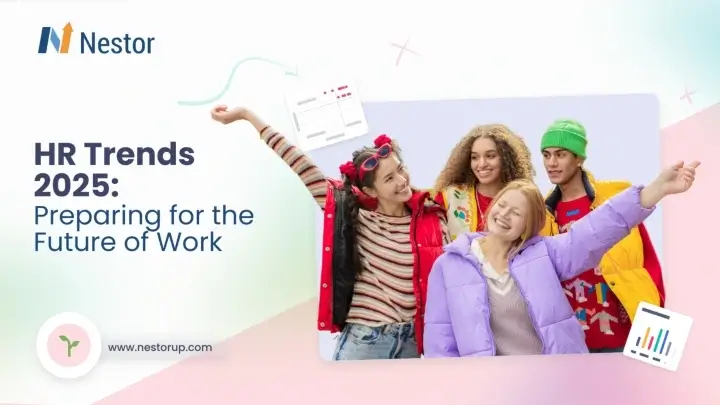Is Productivity Paranoia the New Hidden Effect of the Hybrid Work Model?
10 min read

Over the last few years, the hybrid work model has forced businesses to change how they approach work and their employees. And while this new model brings worthwhile benefits to both employers and employees, it has given birth to a new series of challenges. And productivity paranoia may just be at the top of that list.
In this article, we’ll look at the causes and effects of productivity paranoia, the role hybrid work plays, and the main strategies and actions that HR departments and managers can take to find a solution.
What is productivity paranoia?
Productivity paranoia represents the significant difference between employers’ and employees’ perceptions of productivity levels. Or, in other words, productivity paranoia is a manager’s fear that their employees aren’t as productive as they could, should, or claim to be. But how big is this difference in perception?
According to a study on hybrid work conducted by Microsoft in 2022, out of the 20,000 surveyed people, only 12% of the leaders said they had full confidence in their team’s productivity. A stark contrast to the 87% of employees reporting that they are productive.
What makes managers experience productivity paranoia?
According to Annie Morris, Editor-in-Chief at Made in CA: “With employees working from home and in a different environment, it can be challenging for managers to accurately assess their productivity levels. Additionally, remote work has introduced new distractions and challenges, such as balancing home life and work, which can impact productivity.”
It’s worth pointing out that productivity paranoia can also be a cultural problem caused by pre-existing issues, like a general lack of trust that leads to micromanagement. However, that isn’t always the case. Leaders can experience productivity paranoia due to multiple reasons, including:
Old ways of measuring productivity
Traditionally, high levels of productivity are linked to a high number of work hours and to physically be seen working. This was especially true in the office workspace, where a manager could easily notice how each employee used to spend their time and who was putting in extra hours. Still, this wasn’t a guarantee of being productive.
Moreover, the four-day work week, successful for most firms that have tried it, has proven that people can do more with less. All without losing productivity and increasing personal and job satisfaction in the process. This is a good example of why numbers don’t always tell the full story.
Unclear communication
In some cases, productivity paranoia can simply be a result of miscommunication. Without establishing and discussing clear goals, deadlines, and expectations, employees can struggle to self-evaluate their performance and know whether they’re meeting performance standards or not.
According to John Everton, Technical Director at Bravo Benefits: “Without intentional efforts to ensure that workers and managers are communicating effectively, there can be the danger that managers perceive a drop in productivity. As the sense of ‘community’ and ‘team’ dissolves, so do relationships, and this is where a disconnection can seep in.”
Efficient communication between leaders and their teams can also help each individual better prioritize tasks and focus on the most important projects.
Unrealistic expectations
Many companies saw a boom in profit margins during the pandemic, however, things have been returning back to normal. And how is this related to productivity paranoia?
If executives and leaders expect to maintain the same levels of success, they might ask employees to be more productive or believe they aren’t productive enough. However, this has little to do with people’s work output and everything to do with a temporary trend that is now over.
Tracking tools
Companies that implement tracking or surveillance tools send a clear message to their workforce. The major shortcoming of work-tracking programs is that they monitor activity instead of the outcome. They focus on quantity instead of quality. It’s an approach that, on paper, should bring results but, in reality, has the opposite effect:
Employees feel the lack of trust, they see it as unjust, they grow resentful, then become disengaged, and then start looking for organizations with healthy work environments.
Instead of increasing productivity, monitoring software can lead to resignations or productivity theater. This is a situation in which people will join meetings that don’t require their input, deliver work and emails at strategic hours, or simply increase their activity without maximizing the overall impact.
Has hybrid work widened the gap between managers and employees in perceived productivity?
Yes, hybrid work has contributed to the gap in perceived productivity.
85% of leaders say the shift to hybrid work has made it challenging to have confidence that employees are being productive.
— Microsoft study
The emphasis should be on “perceived productivity”. That’s because, if anything, hybrid work has actually empowered people to be even more productive and make better use of their time.
A certain percentage of employees will regard it as an opportunity to slack and take advantage of the situation. But the vast majority don’t follow such practices and the activity and performance metrics are there to prove it.
At the same time, the responsibility shouldn’t fall entirely on the shoulders of leaders or HR specialists. After all, they also need time to adapt to this new way of doing and evaluating work. According to Seb Hall, Founder & CEO of Cloud Employee:
“Clear, written communications and deliverables have helped a lot with mitigating this (productivity paranoia), but some leaders are still very skeptical, even though you can clearly measure productivity. We can’t blame them because it’s hard to break habits and heuristics that you’ve learned over years.”
It’s normal that big changes require longer periods to adapt. And it’s just as normal to face obstacles along the way. But if the company has a healthy and solid culture that is reflected across departments and processes, then productivity paranoia shouldn’t arise in the first place.
What actions are needed to bridge the productivity paranoia gap?
Although productivity paranoia is a real challenge in the new hybrid work model, there are solutions that HR managers and leaders can implement together with employees:
1. Create a work environment and culture around trust
Culture is more important than ever in the hybrid world
Flexible work arrangements and new ways of working have shifted workplace expectations. For remote teams to work together successfully, the hybrid model requires an even stronger focus on culture. The company culture needs to evolve and keep pace with these changes to avoid situations like the productivity gap.
This is where the crucial role of trust comes in. Building a culture of trust and mutual understanding will help create bonds between managers and their teams. This, in turn, will lead to increased levels of satisfaction and engagement in the workplace.
A culture of trust is essential for high productivity
Employees perform better when they feel safe, encouraged, and supported by their work environment and leaders.
After two decades of research, Paul J. Zak, Harvard researcher, found that “compared with people at low-trust companies, people at high-trust companies report 74% less stress, 106% more energy at work, 50% higher productivity, 13% fewer sick days, 76% more engagement, 29% more satisfaction with their lives, and 40% less burnout.”
Ways to build a culture of trust
It takes time to build a culture of trust, but the benefits are worth it. Open and consistent communication, showing genuine care in understanding people’s needs and expectations, and giving them a voice to manifest their interests in the workplace are ways to build a culture that drives organizational success.
- Encourage open communication: Communication is one of the core values of strong company culture. Especially in these times of uncertainty, transparent communication is vital in providing support and equipping people with the information they need to perform their jobs and feel safe. Moreover, with the rise of hybrid work models, communication is one of the critical soft skills required for any job role. So, make sure to help your employees develop this skill and measure their progress toward the proficiency level desired.
- Show recognition and gratitude: Congratulate people for their accomplishments and initiatives. And encourage them to praise each other and share their appreciation. Leaders can support these behaviors through the right incentives or simple and incredibly efficient positive feedback.
- Enable flexible work & personal development: Give your workforce opportunities to pursue interests or develop new skills according to their desires and need for growth. You can encourage them to participate in cross-functional teams, take on new job responsibilities or access personalized development opportunities to make lateral moves inside the organization. Sometimes, these can lead to an even higher increase in satisfaction than advancing in their careers upward.
2. Increase alignment and transparency
Setting clear expectations and objectives leads to increased alignment and transparency, by making work visible to everyone. Thus, everybody can reach a common understanding of what productivity and performance really mean.
Once clear expectations and objectives are set, leaders should support and empower their people to take responsibility for the business outcomes and get there using their unique skills and abilities. At the same time, leaders should offer employees visibility on how their work can contribute to a higher purpose.
According to Gallup, “organizations have more success with engagement and improve business performance when they treat employees as stakeholders of their own future and the company’s future. This means focusing on concrete performance management activities, such as clarifying work expectations, getting people what they need to do their work, providing development, and promoting positive coworker relationships.“
Regular check-ins: one of the pillars of alignment & transparency
Conducting feedback sessions and check-ins at regular intervals can help both managers and employees feel confident that they are on the right track. These sessions bring back the long-term focus and create a stronger connection between people, who can work together on overcoming personal or work-related challenges.
These meetings are also an opportunity for workers “to be proactive in communicating one’s work progress and accomplishments. Regular check-ins and progress reports can help to build trust and ensure that everyone is on the same page.” – Annie Morris.
3. Redefine the leadership role
Instead of being centered around close observation and control, modern managers need to become more like mentors or coaches, who are there to support and encourage each member of the team to reach their full potential.
As Josh Bersin points out in his HR Predictions for 2023 report, “every company will need to revisit its leadership model.” New leadership initiatives, adapted to the hybrid world, will be human-centric and need to find the right balance between high productivity, empathy, and the overall wellbeing and development of employees.
Redefining and having a new understanding of leadership will also help reduce productivity paranoia. As Annie Morris explains: “To bridge the productivity paranoia gap, it’s important for both managers and employees to have open and honest conversations about what they consider to be productive work. Managers should make it a priority to understand each employee’s strengths, challenges, and work styles, and provide clear goals and expectations for what is considered productive work.”
Final thoughts
Although productivity paranoia is a new concept, the causes and actions that lead to its emergence are as old as time.
In any workplace — office, hybrid, or remote — it’s difficult to create an atmosphere that fosters growth and confidence without basic trust, which is the foundation of any relationship, including professional ones.
Hybrid environments have indeed made it more challenging for leaders to actually see their employees work, but then again, the purpose of hybrid and remote work is to empower employees to deliver results from anywhere during their time of peak productivity.
A culture of trust, combined with increased transparency, solid communication, and a redefined leadership role, can make all the difference in preventing productivity paranoia. Once both sides know what they expect from one another and what they want to achieve together, then it’s all a matter of trusting each other to work towards a common goal and what’s good for the company, their colleagues, and themselves.








